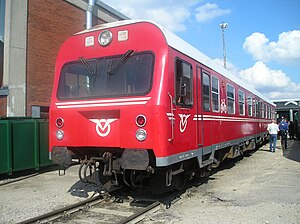OHJ MO
| OHJ MO 25/26 | |
|---|---|
|
Railcar MO of the OHJ in the Danish Railway Museum Odense
|
|
| Numbering: | MO 25 – MO 26 |
| Number: | 2 |
| Manufacturer: |
MaK Germany Kiel |
| Year of construction (s): | 1961 |
| Retirement: | 2007 |
| Axis formula : | (1A) '(A1)' |
| Gauge : | 1435 mm ( standard gauge ) |
| Length over buffers: | 26,400 mm |
| Height: | 4,050 mm |
| Width: | 2,825 mm |
| Trunnion Distance: | 19,000 mm |
| Bogie axle base: | 2,000 mm |
| Empty mass: | 43 t |
| Top speed: | 120 km / h after conversion: 100 km / h |
| Installed capacity: | 2 × 230 HP 2 × 300 HP |
| Motor type: | 2 × twelve-cylinder Deutz F12L714 after conversion: 2 × eight-cylinder Deutz BF8L513 |
| Number of traction motors: | 2 |
| Drive: | diesel-hydraulic |
| Seats: | 66 after renovation: 64 |
| Floor height: | 1,225 mm |
| Classes : | 2. |
The railcars OHJ MO 25/26 were built in 1961 by Maschinenbau Kiel with the serial numbers 516 and 517 for the Danish private railway Odsherred Jernbane to operate the route from Nykøbing Sjælland to Holbæk on the island of Zealand . To a large extent, they correspond to the MaK GDT series .
history
The GDT was developed by Maschinenbau Kiel for small and private railways in the early 1950s. Eleven railcars were built for North German private railways.
The Danish Odsherreds Jernbane was supplied by MaK with two related multiple units. The vehicles delivered in 1961 were classified there as MO 25 and MO 26, the vehicles equipped with 66 seats had car crossings and a maximum speed of 120 km / h. They could carry up to three four-axle passenger coaches .
Technical Equipment
The motors each drove the axles on the inside of the bogies.
In contrast to the GDT supplied to German private railways, the railcars had a double door in the middle of the car and a single door at each end of the car. For the transition to other vehicles, they had end wall transitions with retractable rubber beads . They were equipped with a luggage room and a toilet.
They were delivered in a red color with a cream-colored decorative line and a silver roof. They had at the end faces as peak signal light centered on the roof and a right under the cab window. During a renovation, a triple headlights with two additional tail lights were installed.
MO 25 was transferred to MaK in Kiel on March 3, 1981, where it received a new gearbox.
MO 26 was badly damaged by vandalism in Holbæk in 1976. On September 21, 1979, he was damaged again in a collision with a truck in which eight people were injured. The repairs were carried out by MaK in Kiel, from where he returned to planning service in June 1980.
In 1997 MO 25 was modernized, followed in 1999 by MO 26. They were given a driver's cab without a transition at one end and an emergency driver's cab with a transition at the other end. The decorative line has been replaced by a white double line. The interior was renewed and the folding doors were replaced by sliding and sliding doors.
Sidecar Bl 230/31
In the same year the sidecars Bl 230 and Bl 231 were purchased for the railcars. They had 84 seats and two double doors for changing passengers.
Control car Bls 230/31
Bl 230 was expanded into a control car between 1992 and 1993 and was given a closed end of the car. Bl 231 followed in 1995. After the conversion, they were given the series designation Bls with the same vehicle numbers.
During the conversion, the vehicles were equipped with a communication system specially developed for OHJ by the Swedish company Hogia. This made it possible to operate the control car with locomotives of the type OHJ MX .
Calls
In addition to being used on the main line, the railcars drove trains on the DSB route from Holbæk to Copenhagen, and they also carried other passenger coaches. They were able to take advantage of their high speed on this section of the route.
After the conversion at the end of the 1990s, motor coaches and sidecars were almost exclusively operated as fixed double units. In some cases the control cars were used in locomotive-driven trains.
Vestsjællands Lokalbaner A / S (VL)
In 2003, with the transfer of Odsherred Jernbane to Vestsjællands Lokalbaner A / S (VL), all four vehicles were taken over by the new company.
Whereabouts
After one of the two trains was shown at an exhibition in the Railway Museum in Odense in 2007, both units were sold to Henriksen in Aarhus for scrapping in the same year .
Web links
- Odsherred Jernbane - OHJ - Odsherredsbanen. Motor locomotives. In: jernbanen.dk. Retrieved January 29, 2018 (Danish).
- Locomotives from Kiel. Delivery list. Retrieved January 29, 2018 .
- Odsherreds Jernbane (OHJ). In: 1435mm.net. Retrieved January 29, 2018 (Danish).
- Privatbanernes MaK Dieselmotorvogne. In: kwmosgaard.dk. Retrieved January 29, 2018 (Danish).
- MaK GDT profile. In: sebtus.de. Retrieved January 29, 2018 .
